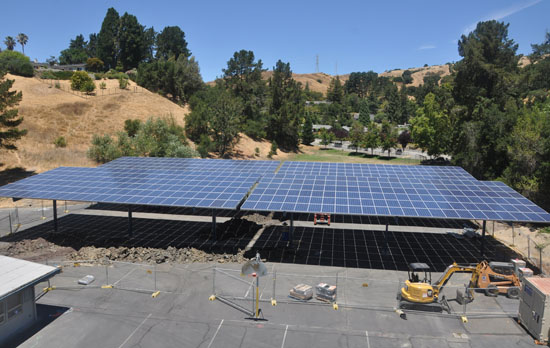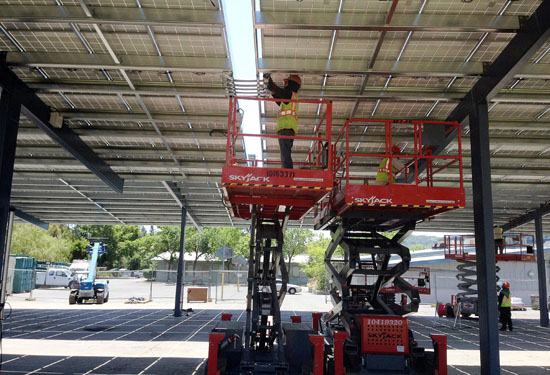| | Published July 13th, 2016
| Solar Installations Sprouting at Lamorinda Schools
| | | By Victor Ryerson |  | | Solar panels are being installed at Orinda Intermediate School, above, as well as at all OUSD elementary schools and at Lamorinda high schools. Photo Andy Scheck |
Looking like overgrown carports, large solar panel arrays are cropping up on all of Lamorinda's high school campuses this summer, and on all of the lower schools in Orinda as well.
 They are designed to generate power from the sun to meet some or all of the schools' energy needs, but they will also lessen the schools' carbon footprint, provide covered parking areas for teachers and students, aid the installation of air conditioning for a more comfortable learning environment, and even serve as a valuable teaching tool for students inheriting a world that must rely on cleaner sources of energy.
They are designed to generate power from the sun to meet some or all of the schools' energy needs, but they will also lessen the schools' carbon footprint, provide covered parking areas for teachers and students, aid the installation of air conditioning for a more comfortable learning environment, and even serve as a valuable teaching tool for students inheriting a world that must rely on cleaner sources of energy.
 Most residents seem to agree that installing solar generating facilities is the right thing to do, and all of the Lamorinda districts expect that their schools will have solar generating systems. Lafayette Elementary School District was the first to install them, and has been using solar power since 2010. Moraga is hoping to join the solar club if a bond issue on the upcoming November ballot provides funding.
Most residents seem to agree that installing solar generating facilities is the right thing to do, and all of the Lamorinda districts expect that their schools will have solar generating systems. Lafayette Elementary School District was the first to install them, and has been using solar power since 2010. Moraga is hoping to join the solar club if a bond issue on the upcoming November ballot provides funding.
 There are differences of opinion about the best way to fund the solar plants, and in one instance the aesthetics of the structures is causing angst among some neighbors, but all indications are that the striking structures will be as universal as athletic fields at area schools.
There are differences of opinion about the best way to fund the solar plants, and in one instance the aesthetics of the structures is causing angst among some neighbors, but all indications are that the striking structures will be as universal as athletic fields at area schools.
 Acalanes Union High School District will have the largest installations, with construction currently underway at all of its comprehensive high school campuses. The most powerful array, at Las Lomas in Walnut Creek, will provide a guaranteed reduction of 1,200 kilowatts used by the school, followed by Miramonte's, which will reduce use by 1,116. Kilowatt reductions at the other campuses are slightly less. The reduction of the district's carbon footprint will be the equivalent of taking 350 cars off the road, officials say.
Acalanes Union High School District will have the largest installations, with construction currently underway at all of its comprehensive high school campuses. The most powerful array, at Las Lomas in Walnut Creek, will provide a guaranteed reduction of 1,200 kilowatts used by the school, followed by Miramonte's, which will reduce use by 1,116. Kilowatt reductions at the other campuses are slightly less. The reduction of the district's carbon footprint will be the equivalent of taking 350 cars off the road, officials say.
 AUHSD's solar panel arrays will be backed up by Tesla batteries, which will store unused power for peak period use. During the daytime hours, the solar panels will generate electricity for the school's needs. The systems are tied into the electric grid, and excess power generated during peak periods, such as afternoons and summers, will be sold to PG&E. Conversely, excess needs will be satisfied by PG&E when required. Such high-use facilities as stadium athletic lights, tennis court lights and swimming pools make high schools big power users, and facilities manager Dave Humphrey says the systems will never zero out or produce a positive income stream. California Public Utilities Commission regulations also limit the district's overall production to a maximum of 85 percent of its needs under the district's power purchase agreements, he says, so the systems are precluded from generating positive cash flow until a buyout opportunity in 25 years makes it feasible. In the meantime, power supplier Solar City pays for the installations and maintains them under a service agreement, and sells power to the district at a specified rate per kilowatt hour.
AUHSD's solar panel arrays will be backed up by Tesla batteries, which will store unused power for peak period use. During the daytime hours, the solar panels will generate electricity for the school's needs. The systems are tied into the electric grid, and excess power generated during peak periods, such as afternoons and summers, will be sold to PG&E. Conversely, excess needs will be satisfied by PG&E when required. Such high-use facilities as stadium athletic lights, tennis court lights and swimming pools make high schools big power users, and facilities manager Dave Humphrey says the systems will never zero out or produce a positive income stream. California Public Utilities Commission regulations also limit the district's overall production to a maximum of 85 percent of its needs under the district's power purchase agreements, he says, so the systems are precluded from generating positive cash flow until a buyout opportunity in 25 years makes it feasible. In the meantime, power supplier Solar City pays for the installations and maintains them under a service agreement, and sells power to the district at a specified rate per kilowatt hour.
 Orinda Union School District has taken a different approach to ownership. It is installing solar systems this summer at Orinda Intermediate School, and at Wagner Ranch, Glorietta, Del Rey and Sleepy Hollow elementary schools, buying them outright and paying for them through the sale of power. Although smaller than the installations at the high schools, the five systems are expected to generate power in excess of the schools' needs and earn thousands of dollars in benefits for the district each year. The reason for the different financial outcome for the district is the funding method selected, and OUSD has been very fortunate. Specifically, with the help of low-cost bond financing, the district has purchased the systems instead of contracting with an owner solar company to buy the power under a power purchase agreement.
Orinda Union School District has taken a different approach to ownership. It is installing solar systems this summer at Orinda Intermediate School, and at Wagner Ranch, Glorietta, Del Rey and Sleepy Hollow elementary schools, buying them outright and paying for them through the sale of power. Although smaller than the installations at the high schools, the five systems are expected to generate power in excess of the schools' needs and earn thousands of dollars in benefits for the district each year. The reason for the different financial outcome for the district is the funding method selected, and OUSD has been very fortunate. Specifically, with the help of low-cost bond financing, the district has purchased the systems instead of contracting with an owner solar company to buy the power under a power purchase agreement.
 With the help of a consultant, the district looked closely at both options, and concluded that outright ownership was the way to go. Moreover, the consultant helped the district obtain Clean Renewable Energy Bond financing, which provides a low rate of interest. The process is competitive, and Stuart House, the district's facilities manager, is ecstatic about the result.
With the help of a consultant, the district looked closely at both options, and concluded that outright ownership was the way to go. Moreover, the consultant helped the district obtain Clean Renewable Energy Bond financing, which provides a low rate of interest. The process is competitive, and Stuart House, the district's facilities manager, is ecstatic about the result.
 "We won't spend one penny of taxpayer money," he said, and the bond payoff will occur in 17 years. House anticipates that the district will receive $50 thousand annually in benefits over and above the bond cost from sale of the excess power, and that these benefits might continue for 25 years - all without any taxpayer investment. The benefits will save dollars that would otherwise have to be paid to PG&E from the district's general fund, and those funds will be available to the district for other uses.
"We won't spend one penny of taxpayer money," he said, and the bond payoff will occur in 17 years. House anticipates that the district will receive $50 thousand annually in benefits over and above the bond cost from sale of the excess power, and that these benefits might continue for 25 years - all without any taxpayer investment. The benefits will save dollars that would otherwise have to be paid to PG&E from the district's general fund, and those funds will be available to the district for other uses.
 There will be side benefits as well. More than just being a symbolic gesture to encourage environmental awareness, the systems will provide a hands-on tool for students to use to calculate actual impacts. For example, touch-screen kiosks at OIS will provide information about the amount of energy being used at the school, and furnish data necessary for science and math classes to calculate the tons of carbon dioxide production spared and the gallons of gasoline saved. On a more mundane level, the shady structures will afford covered parking for automobiles at all of the campuses, with very few parking spaces lost because of the construction. OUSD's consideration of solar power began when it sought to air-condition its schools, but was discouraged by the $10 million cost. The new power source now brings that possibility within range.
There will be side benefits as well. More than just being a symbolic gesture to encourage environmental awareness, the systems will provide a hands-on tool for students to use to calculate actual impacts. For example, touch-screen kiosks at OIS will provide information about the amount of energy being used at the school, and furnish data necessary for science and math classes to calculate the tons of carbon dioxide production spared and the gallons of gasoline saved. On a more mundane level, the shady structures will afford covered parking for automobiles at all of the campuses, with very few parking spaces lost because of the construction. OUSD's consideration of solar power began when it sought to air-condition its schools, but was discouraged by the $10 million cost. The new power source now brings that possibility within range.
 Not all of the impacts of the program are so rosy, however. A group of residents on Martha Road across the street from Glorietta School, which is slated to have a separate solar array close to the street on each side, is seeking a stop work order and a better solution to the issue. They point out that the installations at all the other schools are smaller and are out of the sight of neighboring residences, and that the massive structures at Glorietta are inconsistent with the surrounding neighborhood's character and village feel. Discussions with the district are in progress.
Not all of the impacts of the program are so rosy, however. A group of residents on Martha Road across the street from Glorietta School, which is slated to have a separate solar array close to the street on each side, is seeking a stop work order and a better solution to the issue. They point out that the installations at all the other schools are smaller and are out of the sight of neighboring residences, and that the massive structures at Glorietta are inconsistent with the surrounding neighborhood's character and village feel. Discussions with the district are in progress.
 In the meantime, expect to see construction of the big arrays underway at all of the area's schools. The power they produce should be flowing by the time the first bell rings in August.
In the meantime, expect to see construction of the big arrays underway at all of the area's schools. The power they produce should be flowing by the time the first bell rings in August.

|
 | | Workers install solar panals at OIS. Photo Victor Ryerson | | | | | | | | | | | |





